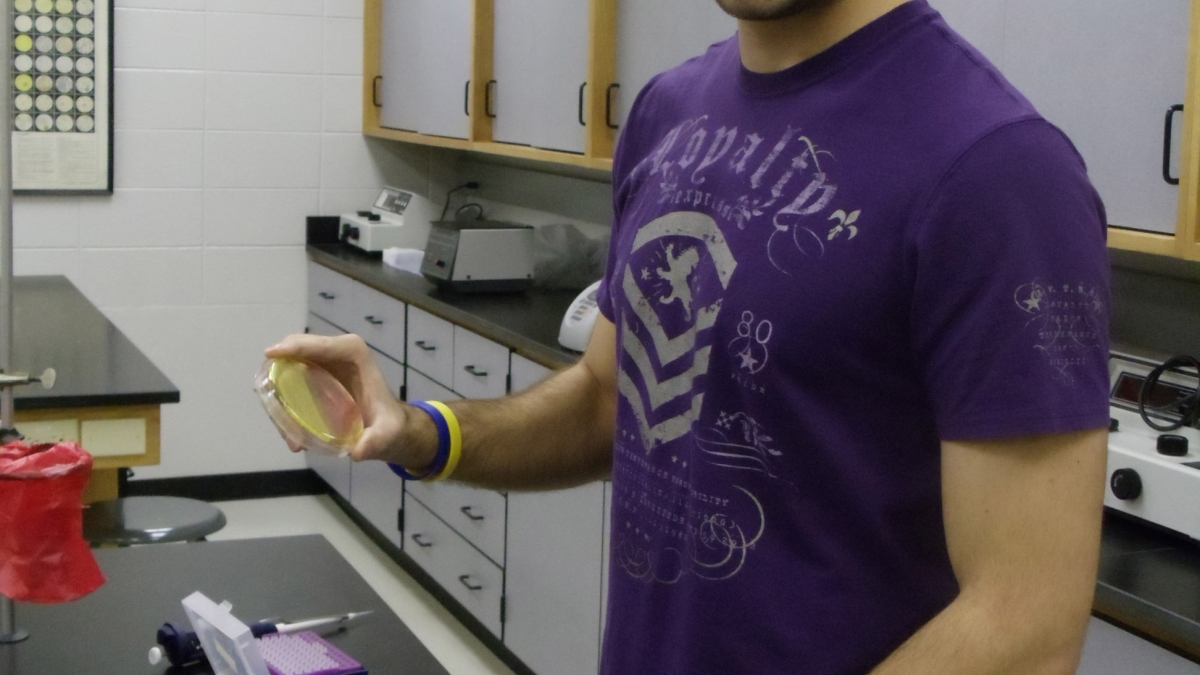Sophisticated lab equipment draws Illinois student to ASU

There are plenty of reasons to visit metropolitan Phoenix; the opportunity to use cutting-edge technology to identify dangerous bacteria probably isn’t a common one. But that was the motivation that drew Peter Waller from Lewis University in Illinois to Arizona State University’s West campus and the lab of Todd Sandrin, associate director of the Division of Mathematical and Natural Sciences (MNS) in ASU’s New College of Interdisciplinary Arts and Sciences.
Waller spent a week in Sandrin’s lab working with a sophisticated technique for “fingerprinting” microorganisms.
The technique, which Sandrin and his students have been exploring in their efforts to characterize strains of different types of microorganisms, requires the use of highly specialized scientific equipment – specifically a state-of-the-art mass spectrometer that is part of MNS’ complement of research resources.
“A mass spectrometer is a very sensitive and accurate scale that weighs very small things,” Sandrin said. “It does so by vaporizing small amounts of substances, such as microorganisms, and launching them down a tube. Based on the length of time it takes different molecules to travel through the tube, their masses can be determined.”
Waller, a biology major at Lewis who aspires to become a family practice physician, has been researching MRSA with fellow Lewis students under the direction of James Rago, a biology faculty member at the private liberal arts college. MRSA is a bacterial infection that is highly resistant to some antibiotics.
Waller and other Lewis students are engaged in projects including a study of MRSA and other microorganisms found in samplings taken from ambulances. During his week in Sandrin’s lab, Waller had the opportunity to observe and conduct a procedure known as MALDI-TOF mass spectrometry-based microbial fingerprinting to characterize strains of bacteria from those samplings.
“Now that I know how the procedures work and what information I can receive from the results, I can apply this knowledge to my own research work,” Waller said. “This experience has allowed me to take charge of a specific research opportunity and see it through from start to finish.”
Waller’s visit to ASU came about after Sandrin met Rago during a meeting at the College of William and Mary sponsored by the Council on Undergraduate Research.
“Jim indicated that he had expertise working with a group of microorganisms with which we had worked previously,” said Sandrin, whose own interests include studying the huge variety of microbes found in Kartchner Caverns southeast of Tucson. “Jim was intrigued by some of the techniques to fingerprint microorganisms that my students and I had been exploring in my lab. Given our mutual interests, we made it a point to chat after the meeting about possible collaborations.”
The initial discussion focused simply on having Sandrin’s lab fingerprint some of Rago’s microorganisms. But Sandrin said the two later realized that the collaboration might represent the chance to provide one or more undergraduate students with a unique opportunity to gain hands-on experience learning and performing the fingerprinting technique.
“I hope this is the first of many such trips,” Rago said. “The benefits for our students are obvious and immeasurable. Lewis University and other schools benefit by forming meaningful collaborations, and our students get to have a hand in crafting and advancing scientific knowledge.”
According to Sandrin, the mass spectrometer in his lab is not only extremely versatile but also user-friendly. “I routinely have high school students operate it when they tour the West campus,” he said.
Also remarkable is the fact that the mass spectrometer often allows the user to cut the time needed to gain molecular fingerprints from more than 12 hours down to a few seconds. “That’s much faster than even the rate at which such fingerprinting is supposedly performed on TV shows like CSI,” Sandrin noted. He said his faculty colleagues in MNS are also making use of the instrument; some have begun incorporating it into projects involving analysis of air pollutants and anti-cancer drugs.
Sandrin echoed Rago’s sentiments about their hope to continue the collaboration between universities. He said New College enables undergraduates to gain meaningful, hands-on experience solving real-world problems.
“New College faculty members recognize the value of research experience for undergraduates,” Sandrin said. “Unlike many smaller academic institutions, New College has the infrastructure to allow students to conduct research with faculty at the very frontiers of scientific knowledge. I am confident that we will continue to gain national recognition as a unique place where students can work alongside a renowned faculty member and use state-of-the art instrumentation to gain new skills and begin to solve problems facing society today.”